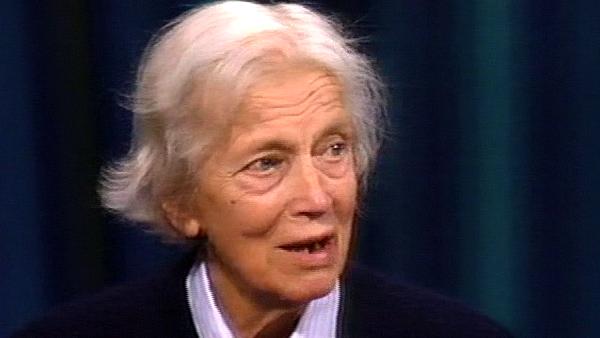NEXT STORY

Crystallography at Oxford University
RELATED STORIES

NEXT STORY

Crystallography at Oxford University
RELATED STORIES



|
Views | Duration | |
|---|---|---|---|
| 11. More help from my cousin Sir Charles Harrington | 1 | 150 | 02:25 |
| 12. Pink teeth | 190 | 04:30 | |
| 13. Crystallography at Oxford University | 229 | 06:14 | |
| 14. Work on thallium with HM Powell | 142 | 02:30 | |
| 15. Working with JD Bernal in Cambridge | 267 | 04:09 | |
| 16. Photographing pepsin crystals | 208 | 04:54 | |
| 17. The beginning of my rheumatoid arthritis | 320 | 01:32 | |
| 18. Sharing a research student with JD Bernal | 158 | 01:29 | |
| 19. Choosing not to work on defence against chemical warfare | 172 | 01:49 | |
| 20. My first insulin crystals | 206 | 02:20 |


These were the Christmas lectures he gave for children, in, I think, about 1924 or 1925, and, again, it's my mother's influence; she thought they sounded interesting and bought them for me for a Christmas present. So I was, I was very much interested in that. When I got to Oxford, I found that I couldn't, in fact, start to go to courses by the x-ray crystallography because there was no crystallography, x-ray crystallography taught, and nor could I go to biochemistry, because the biochemistry lab was just being built. It was a gift from the Rockefeller Foundation, and was looked after by Sir Archibald Garrod, who was the just-retiring Regis Professor of Medicine. And he was a friend of my father's, rather luckily, because his daughter was a pre-historian, an archaeologist and dug caves in Palestine, and so they suggested that I should go around and see Archibald Garrod, and so I had a lovely morning being shown over the new, not-yet-used, biochemistry lab, and told stories of what Archibald Garrod himself had worked on. And this, of course, is a fascinating subject, which is well known now, on inborn errors of metabolism. When I went to Cambridge later, to which he retired, I borrowed his book and read it, and I, I still remember some of it, which features the discovery of pink teeth in a certain family he met in the course of his medical work. And this was through the metabolism of the porphyrins having gone astray, and the one... the isomer was deposited in the teeth, was one in which the side-chains were differently arranged from all of the rest.
[Q] And it coloured the teeth?
It happened... it happened with haemoglobin. And actually, it happened again. I'd come across this fact from Robinson's lectures. Robinson had come to us as a new, very famous inorganic chemistry professor at Oxford during the time I was an undergraduate, and I remember his lectures on the porphyrins, particularly on the discovery of the structure of haematoporphyrin being the apex of the five-membered rings of acetyl, propionyl, residues alternately sort of long-short, long-short, long-short, long-short, is one, and then the different varieties of the permutations of these spaces: long-short, long-short, long-short, short-long, which is the haemoglobin one. And Robinson had amused himself giving the orders of these residues and saying why this odd one had occurred in pink teeth, but leaving the haemoglobin, the actual one, until the last. So one was waiting all the time to know what haemoglobin was like.
British pioneer of X-ray crystallography, Dorothy Hodgkin (1910-1994), is best known for her ground-breaking discovery of the structures of penicillin, insulin and vitamin B12. At age 18, she started studying chemistry at Somerville College, Oxford, then one of the University of Oxford colleges for women only. She also studied at the University of Cambridge under John Desmond Bernal, where she became aware of the potential of X-ray crystallography to determine the structure of proteins. Together with Sydney Brenner, Jack Dunitz, Leslie Orgel, and Beryl Oughton, she was one of the first people in April 1953 to see the model of the structure of DNA, constructed by Francis Crick and James Watson. She was awarded the 1964 Nobel Prize in Chemistry and is also known for her peace work with organisations such as Science for Peace and the Medical Aid Committee for Vietnam. All recorded material copyright of The Biochemical Society.
Title: Pink teeth
Listeners: Guy Dodson
Guy Dodson studied chemistry and physical science at the University of New Zealand, followed by a PhD on the crystallographic study of an alkaloid. In 1961, he came to Oxford to work on the crystal structure of insulin. In the mid 1970s Guy and his wife moved to York University to establish a laboratory. In addition to insulin studies the laboratory has investigated many complex molecules of medical significance, including haemoglobin, myoglobin, HIV related proteins, proteases and proteins involved in managing nucleic acids in cells. In 1993, he went to the NIMR in London to establish a crystallographic group in an environment that spanned molecular, physiological and disease-related disciplines. Here his research began on some cell signalling proteins. His interests on medically relevant proteins included prions, malarial and TB proteins, and some clinically relevant thrombin inhibitors. Guy Dodson retired in 2004 but is still finding much to do in York and the NIMR.
Tags: Sir Archibald Garrod
Duration: 4 minutes, 30 seconds
Date story recorded: 1990
Date story went live: 02 June 2008